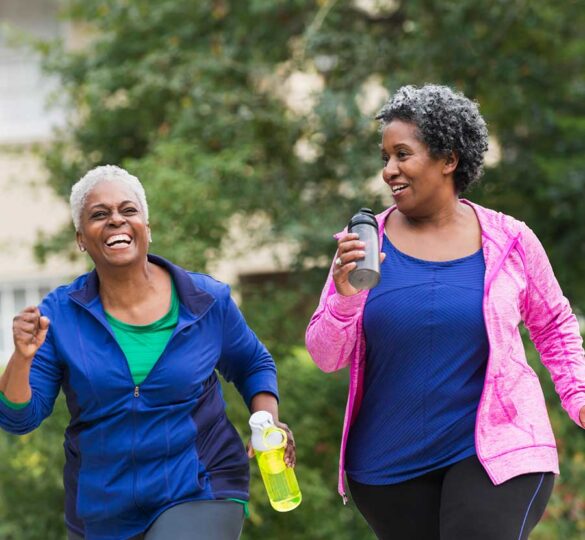Can Exercise Lower Eye Pressure?
Exercise for glaucoma patients can be beneficial. Research has shown that regular exercise lowers intraocular pressure (IOP) in glaucoma patients.

Aerobic Exercise Provides Neuroprotection for Glaucoma Patients
Exercise is an essential part of a healthy lifestyle. Exercise prevents health problems, builds strength, boosts energy, and can lower stress. In addition, research has shown that exercise can also be beneficial for glaucoma patients.
Many glaucoma patients ask their doctors, “What else can I do to help preserve my vision?” One answer may be to get off the couch — and get moving.
High eye pressure causes glaucoma, and research has found that several forms of aerobic exercise help lower intraocular pressure (IOP) in glaucoma patients. In addition, evidence suggests that it can also positively impact other glaucoma risk factors, including diabetes and high blood pressure.
Cardiovascular exercises can improve overall eye health and vision, but it’s especially beneficial to people living with glaucoma. “Aerobic exercise lowers intraocular pressure (IOP), which we know protects retinal ganglion cells,” says Harry A. Quigley, MD, professor and director of glaucoma services at the Wilmer Eye Institute at Johns Hopkins University in Baltimore. “And short-term studies show it may improve blood flow to the retina and optic nerve as well.”
Get Active
Increasing your activity level for better eye health doesn’t have to be complicated and time-consuming. It doesn’t even require rigorous exercise. For example, you can achieve a positive neuroprotective effect by engaging in activities that raise the pulse by just 20 to 25 % — a brisk walk for 20 minutes around the neighborhood or in the park four times a week — can lower your IOP.
Studies show that moderate to vigorous physical activity decreased the average visual field (VF) loss rate by approximately 10 percent.
If walking isn’t for you, consider doing something else that increases your blood flow, like bike riding, swimming, running, dancing, jogging up and down the stairs, etc. No matter what activity you choose, your eyes will benefit, and you’ll also strengthen your heart health.
“Exercise is free, so the price is right, and glaucoma patients should be encouraged to begin an aerobic program after getting consent from their internal medicine physician,” advises Dr. Quigley.
And of course, regular exercise delivers multiple other benefits, including improving blood pressure and heart function and making it easier to keep your weight down.
What’s interesting to note is that to achieve a positive neuroprotective effect, you don’t have to exercise rigorously. Exercises that raise the pulse by just 20-25% — that could be a brisk walk — for 20 minutes, a minimum of four times a week can lower IOP. However, the type of exercise is as important as whether you exercise because some forms of exercise can increase your eye pressure.
Exercises That Can Lower IOP
Low-impact aerobic exercises that lower IOP involve those that moderately raise your heart rate for 20 to 30 minutes. There are many forms of low-impact aerobic exercise.
- Going for a walk
- Jogging on a treadmill or outside
- Riding a bike (stationary or outdoor)
- Swimming
- Taking a Zumba class
- Using an elliptical machine
Anaerobic exercises, like some forms of yoga, can also reduce eye pressure. However, yoga poses that incorporate inversion, like the dolphin and downward-facing dog pose, forearm balance, handstands, headstands, shoulder stands, and wall t-stands, can have the opposite effect and should be avoided by glaucoma patients because they increase pressure in the eye.
Exercises That Can Raise the Risk of Glaucoma
Not all forms of exercise are good for the eyes. For example, exercises that involve straining or bearing down (anaerobic exercise) have the exact opposite effect. In addition, people engaging in anaerobic exercise may hold their breath temporarily while straining, raising eye pressure and further increasing the risk of developing glaucoma or worsening vision loss in people who have the disease.
Examples of anaerobic exercise can include:
- Sit-ups and pull-ups
- Sprinting while running, biking, or swimming
- Weightlifting, particularly powerlifting and bench presses
- Inverted sit-ups, crunches, and squats
Exercise Regularly
Exercising reduces eye pressure as long as you continue to exercise regularly. Find activities that you enjoy and develop the habit of exercising 3-4 times a week. It only takes a few weeks of inactivity for IOP levels to rise.
Neuroprotection from Topical Medications
Although some manufacturers of topical glaucoma treatment medications claim to provide neuroprotective effects, currently, none exist. “There is no evidence that any topical glaucoma medicines can save nerve cells in humans,” says Dr. Quigley, after a review of the available literature on this topic. “Both patients and doctors need to be alert to false claims.”
Consult With Your Doctor
Regular exercise may be a valuable addition to preventing visual loss from glaucoma, but only your eye doctor can assess the effects of exercise on your eye pressure. In addition, some rare forms of glaucoma (such as closed-angle) are not responsive to the impact of exercise, and other forms of glaucoma (for example, pigmentary glaucoma) may develop a temporary increase in IOP after vigorous exercise.
While exercise is beneficial in most cases, it cannot replace glaucoma medications or visits to your eye doctor.
Help Us Find a Cure
While there’s no cure for glaucoma, low-impact exercise is one of the ways glaucoma patients can manage their glaucoma. Advancements in glaucoma care continue to bring us closer to finding a cure. You can help us find a cure with cash, stock, or a vehicle or boat donation. Your support will give hope to those living with glaucoma and accelerate our search for a cure.
Reviewed and updated on May 20, 2022